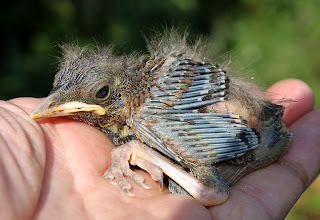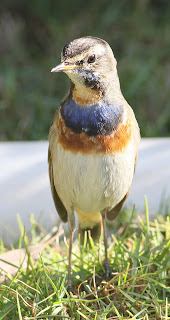At 6am the air on Rawcliffe Moss felt cool and autumnal but thankfully it was windless. Will and I quickly set to and erected our nets in double quick time then grabbed a coffee each before the real work/fun began.
Continuing the theme of last weekend and my solo mid-week session, the highlights of today were an influx of yet more Whitethroats and Willow Warblers together with a suggestion of the beginnings of Chaffinch and perhaps other migration amongst the 12 species handled.
In total we processed 45 birds, 39 new and 6 recaptures. New: 14 Whitethroat, 12 Willow Warbler, 3 Sedge Warbler, 3 Chaffinch, 2 Swallow and 1 each of Blackcap, Lesser Redpoll, Song Thrush, Robin and Wren. Recaptures: 2 Whitethroat, 2 Willow Warbler, 1 Goldfinch and 1 Great Tit.
Both Whitethroats and Willow Warblers were in noticeably good numbers this morning, not only in the plantation where the nets are, but also along the feeding corridor of the well vegetated track margins, a route which runs exactly in a north/south direction. Our 12 new Willow Warblers split 7/5 in favour of adults to juveniles this morning which continues the suggestion of poor breeding success proposed on this blog in recent weeks: the ratio of our new Whitethroats today was the more respectable and expected 3 adults to 11 juveniles.



The 2 Swallows caught were feeding on a low path through the plantation when intercepted by our nets.

Lacking today were any number of Goldfinches feeding on the Niger seed, with one recapture only. When we topped up the feeding devices we noted that they were still more than half full after a previous mid-week fill. However, today’s single Lesser Redpoll capture, a non-resident species, was caught alongside a Niger feeder. We are always amazed by how quickly birds home-in on feed of any sort but in particular the aromatic, shiny, oily black Niger.


Chaffinches have been noticeable by their absence here in June and July, but although we caught only 3 today we detected a slight movement, in fact less than 15 birds overhead, but all contact calling and heading from north to south.

Birding today was uneventful, but with counts of 2 Buzzard, 1 Kestrel, 1 Sparrowhawk, 70 Swallow, 25 House Martin, 1 Great-spotted Woodpecker, 5 Skylark and 5 Linnet.








































































